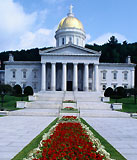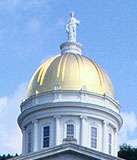 In 1805, Montpelier was made the permanent seat of government by the Legislature. The first State House was a three-story, 10 sided wooden building. The legislators had plank seats with wooden backs. It deteriorated and became overcrowded and was torn down in 1836. In 1805, Montpelier was made the permanent seat of government by the Legislature. The first State House was a three-story, 10 sided wooden building. The legislators had plank seats with wooden backs. It deteriorated and became overcrowded and was torn down in 1836.The Second State House was modeled after the temple of Theseus in Greece and served until 1857 when it was destroyed by fire.   The third and present State House has been occupied since 1859. Its exterior walls are made of granite from nearby Barre; the portico and pillars with Doric capitals were saved from the second State House. The building is topped with a 57-foot dome and a 14-foot wooden statue of Agriculture, mounted on a 6-foot base. The dome is wood, sheathed in copper and covered with gold leaf. The third and present State House has been occupied since 1859. Its exterior walls are made of granite from nearby Barre; the portico and pillars with Doric capitals were saved from the second State House. The building is topped with a 57-foot dome and a 14-foot wooden statue of Agriculture, mounted on a 6-foot base. The dome is wood, sheathed in copper and covered with gold leaf.
The Vermont Senate occupies the east wing and the House of Representatives is located in the center. The executive Chambers are in the front west wing of the building. A recent addition to the rear houses other legislative offices. Among the highlights contained in the building are 65 flags used by Vermont units in the Civil War and 14 from other wars. The Governor's Reception Room is dominated by a 20 by 10 foot painting of the Civil War battle of Cedar Creek. The halls also contain paintings of former governors and other statesmen from Vermont past. |